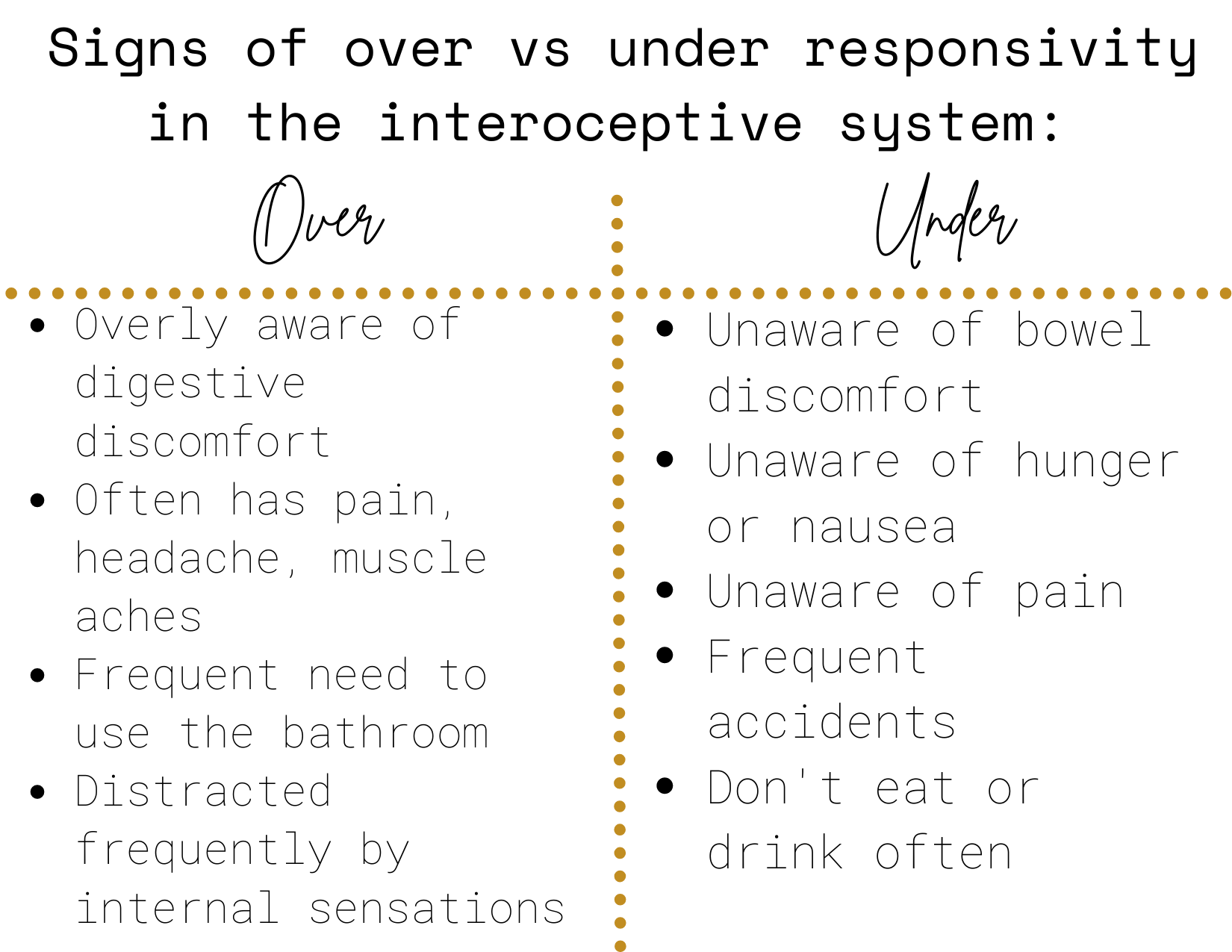Sensory System Series: Interoceptive System
Did you know we had eight senses? The interoceptive system is known as our “hidden sense”. It is our internal sensation allowing us to interpret how our body is feeling on the inside. Reflect on times you have felt sensations within your body. Hunger, thirst, the need to use the bathroom, sleepiness, full stomach, hotness, and heartbeat are all internal sensations providing critical information about the internal conditions of our body.
There are specialized nerve receptors throughout the inside our bodies on our internal organs, bones, muscles, and skin. The receptors tell our brain what our body is feeling for us to respond to meet our body’s needs. The purpose of this system is to keep our body in an optimal balanced state called homeostasis. When our body is not in homeostasis, our daily functioning can be impacted greatly and our emotions!
Introception is closely linked to emotional regulation and mood. If you think about the times when you were hungry or tired, you may have felt crabby or impatient. The more I become hungry, the crabbier I become, commonly known as “hangry” or “hanger.” This is a prime example of how the internal condition of our body influences our emotions. Research has shown when we are able to read our own internal sensations, we are better able to identify and regulate our emotions. This influences our ability to read another person’s physical and emotional cues. As a parent, you have been attuned to your child’s interoceptive system since they were born. Infants can’t tell us how they are feeling. We rely on their behavior to inform our care. If they are crying, our immediate reaction is to try to figure out their unmet need. Do they need a bottle or diaper change? Are they tired? Over time you become more attuned to their behavior and as they grow up they do as well.
We are able to guide and teach children to recognize the internal sensations of their bodies and how to respond. We can talk about how our own bodies feel modeling to them physical signs we feel to recognize in their own body.
Additionally, we can share what we notice in their emotions and behaviors prompting them to notice their internal sensations. For example for a toddler who is upset or “whiny” we can say, “I notice you are upset. What is bothering you? Are you hungry?” You can elaborate on this by sharing your own experience. “Sometimes when I am upset or mad, I am hungry. Once I have a snack, I feel much better.” You may have done this for your child when they were potty training. They may have been squatting in a corner or doing a dance indicating to you they may need to go to the bathroom. You prompt them to become aware of the internal sensation for the need to use the bathroom and guide them on how to respond to this sensation.
As with the other seven sensory systems, the interoceptive system may not function optimally. Each person’s interoceptive system varies. A child’s system may be over-responsive (hypersensitive) or under-responsive (hyposensitive). Over-responsivity means one has a larger than expected emotional or behavioral response to sensory input. It takes little input to produce a sensation. On the other hand, a child may be under-responsive where the child has low arousal where they don’t notice the sensory input and it takes a lot of input to produce a sensation. For example, a child who has an over-responsive interoceptive system may use the bathroom a lot whereas a child who has an under-responsive system may go long periods of time without using the bathroom or have accidents.
Therapeutic Tool Highlight: Emotions Chart
Emotions charts can be placed within a space facilitating emotion identification and regulating techniques. Children can reference it to identify and communicate their feelings to others.
It is important to remember some children may not understand how to respond to interoceptive input, especially children with sensory processing disorders. They may misinterpret the sensory information. Feelings may become mixed up resulting in dysregulation and unwanted behaviors. View their behavior as a form of communication and seek the underlying cause of it.
The above strategies are only a few and may or may not help. Let us know and we’d be happy to provide you with more. We are here to support you!
Check out our sensory system handouts you can purchase individually or as a bundle on our website! A great resource to learn about sensory processing disorder and each of our sensory systems. BONUS: print them off and hang them on the wall for all who pass by to view and learn or share with family, friends or teachers for them to have insight into your child’s sensory system.






